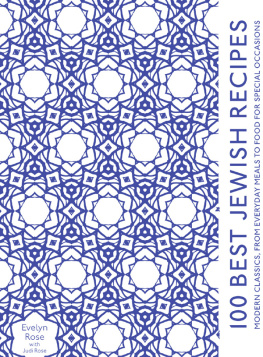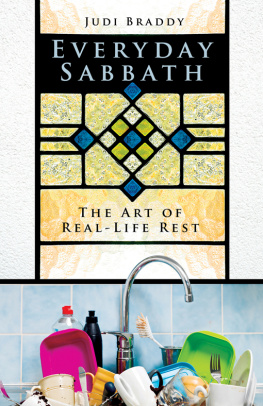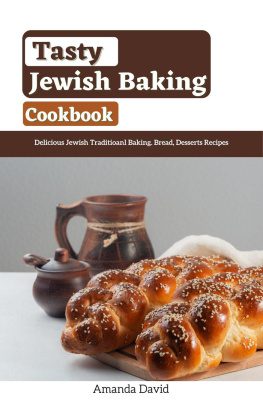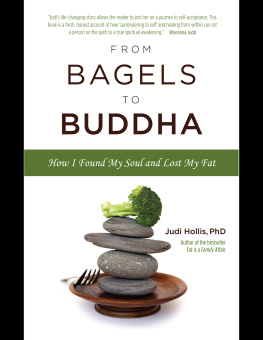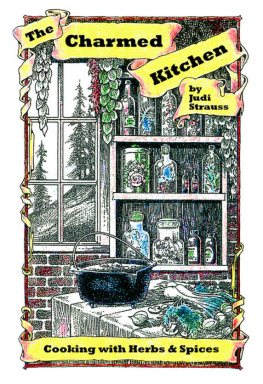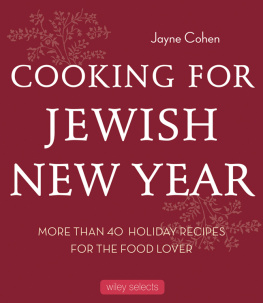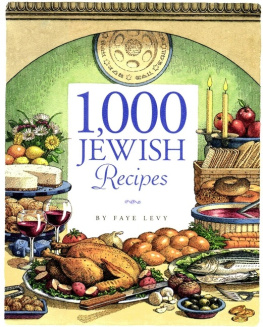Judi Rose - 100 Best Jewish Recipes
Here you can read online Judi Rose - 100 Best Jewish Recipes full text of the book (entire story) in english for free. Download pdf and epub, get meaning, cover and reviews about this ebook. publisher: Pavilion Books, genre: Home and family. Description of the work, (preface) as well as reviews are available. Best literature library LitArk.com created for fans of good reading and offers a wide selection of genres:
Romance novel
Science fiction
Adventure
Detective
Science
History
Home and family
Prose
Art
Politics
Computer
Non-fiction
Religion
Business
Children
Humor
Choose a favorite category and find really read worthwhile books. Enjoy immersion in the world of imagination, feel the emotions of the characters or learn something new for yourself, make an fascinating discovery.
- Book:100 Best Jewish Recipes
- Author:
- Publisher:Pavilion Books
- Genre:
- Rating:4 / 5
- Favourites:Add to favourites
- Your mark:
- 80
- 1
- 2
- 3
- 4
- 5
100 Best Jewish Recipes: summary, description and annotation
We offer to read an annotation, description, summary or preface (depends on what the author of the book "100 Best Jewish Recipes" wrote himself). If you haven't found the necessary information about the book — write in the comments, we will try to find it.
100 Best Jewish Recipes — read online for free the complete book (whole text) full work
Below is the text of the book, divided by pages. System saving the place of the last page read, allows you to conveniently read the book "100 Best Jewish Recipes" online for free, without having to search again every time where you left off. Put a bookmark, and you can go to the page where you finished reading at any time.
Font size:
Interval:
Bookmark:
100 BEST JEWISH RECIPES

MODERN CLASSICS, FROM EVERYDAY MEALS TO FOOD FOR SPECIAL OCCASIONS
Evelyn Rose


Every cook I know has their go-to recipes a handful of tried, trusted and much-loved dishes that always work and never fail to delight. Fans of Evelyn Rose, the doyenne of Anglo-Jewish cooking for over half a century, are no exception. In virtually every copy of the classic The New Complete International Jewish Cookbook there are certain pages where these well-thumbed books naturally fall open to reveal the telltale signs of their owners greatest hits ... a beetroot-pink stain beside Borscht on the Rocks, a trace of red wine in the margin of Florentine Beef Stew, or a buttery fingermark over the method for Lemon Cake.
This new volume represents one hundred of Evelyn Roses own best-loved recipes. With over a thousand in The New Complete alone, choosing just one in ten was no mean feat, but this selection represents not only some of her personal favourites as well as those of her fans but her conviction that Jewish food is a living, evolving cuisine, rooted in tradition but inspired by the present, just as it has been for centuries.
For Evelyn, drawing inspiration from the tastes and ingredients of foreign lands, incorporating current thinking on health and nutrition, and using new technology to save time and effort are the keys to modern Jewish cooking and to securing its future with new generations of cooking enthusiasts.
The recipes in this new collection, from Syrian Cheese Puffs to Gefilte Fish Provenale, epitomize these principles in addition to Evelyns eclectic and adventurous approach to bringing new flavours to the Jewish table. In fact, whenever she was asked for a definition of Jewish food, her answer was simple: Its food that Jews eat, wherever they might live or hail from.
Whether the recipes heritage is haimische, Sephardi, Mediterranean or Asian, my mother passionately believed that each dish must have taam that extra something that makes it taste special, and so worth the effort for busy people to put on their table. She tested and fine-tuned each dish time and time again to ensure success for the home cook. This guarantee of fabulous food and recipes that always work is doubtless the reason why Evelyns definitive work, The Complete International Jewish Cookbook, later revised by my mother and me, has been continuously in print since it was first published in 1976, and why her fans refer to it as their bible.
When my mother wrote these recipes she also added her zest for life, a taste for adventure and her own unique qualities: devotion to her craft, commitment to her readers, and an extra ingredient of her own a large helping of love, all made possible by the support of her companion, taste-taster and greatest fan of all, her husband, Myer. Within these pages, you will find all this and more in generous measure. Enjoy.
Judi Rose
London, 2015
You can almost pinpoint the exact occasion, in the second millennium BCE, when the art of Jewish cookery was born. On that day, the course of world history was changed when the matriarch Rebecca, by the judicious use of herbs and spices, gave the savour of wild venison to the insipid flesh of a young kid, and established a culinary philosophy of taste with economy that has been followed by her descendants ever since.
When Rebecca made her kid casserole and her son Esau sold his birthright for a bowl of lentil soup, the everyday food of those early Jews was primitive in the extreme. Except on special occasions, the staple diet consisted of boiled vegetables such as leeks, garlic and onions and salads of raw herbs, with boiled meat cooked only on a holiday. During the following 2,000 years, the Jews became in turn the subjects of the four civilizations in which the art of the kitchen was first evolved. When the empires of the Egyptians, Persians, Greeks and Romans had faded into history, their cooking methods survived in the kitchens of their former subjects.
To this day, Jewish households, during Pesach () they bake honey and cheese cakes that are a legacy of the many years of Seleucid rule.
If these remembrances of foods past were the sum total of Jewish cooking, it is doubtful that it would have survived to the present day. Jewish tradition teaches that when Moses descended from Mount Sinai he gave the Jews the code of culinary practice by which they have conducted their kitchens ever since, and which has been responsible, to a large extent, for the unique flavour and character of their food.
In the Jewish dietary laws, there are prohibitions: no shellfish; no pig; no carrion; no birds of prey; no thing that crawls upon its belly. Then there are the categories of permitted foods: only those fish that have fins and scales; only those beasts that chew the cud and have cloven hooves; only those birds that have been slaughtered according to the Law. Then there are the cooking and serving instructions for these permitted foods: foods of animal and dairy origin not to be combined either during the cooking or the serving; dairy foods to be served after meat foods only when a specified number of hours has elapsed; meat to be purged of its blood before use.

However, it was in the Ten Commandments themselves that there appeared those instructions which have resulted in the development of some of the most typical of Jewish foods those dishes that can be cooked one day and served the next. On the seventh day thou shalt do no work, neither thy maidservant nor thy manservant, said the Law, and so all day Thursday, and most of Friday before dusk would be spent making salads, liver pt, soups, fruit pies, yeast cakes and, in particular, those meat and vegetable casseroles that could be left in a low oven overnight, such as Cholent and Tsimmes.
The need to differentiate between meat and milk meals encouraged the development of many delicious dairy dishes made from velvety kaese, a soft cheese made from naturally soured milk. These dishes include cheese kreplach (a form of ravioli), lokshen and kaese (noodle and cheese casserole), and the blintze, a paper-thin pancake stuffed with slightly sweetened cream cheese, which is the most famous Jewish dish to be absorbed into international cuisine.
The shortage of kosher meat in the ghettos of medieval Europe forced households to find ways of stretching their meagre supply. Usually, meat would be minced and used as a stuffing for a variety of different doughs and vegetables.
Those Jews who lived in the Middle East stuffed carrots, aubergines, tomatoes and even leeks, using an ingenious metal excavator to remove the vegetable flesh from the skin. When meat became more plentiful, other methods of cooking it were adopted, but all were based on braising or casseroling, for kosher meat is used only a few days after it has been killed and tends to be tough when it is dry-roasted.
Some of the most interesting Jewish foods are those cooked in celebration of a festival (see pages 1215). In biblical times, these festivals were the occasions for the family to make a pilgrimage on foot to the Temple at Jerusalem, where they would offer the first ripe fruits from their fields, as well as bread and cakes made from the new seasons wheat.
Next pageFont size:
Interval:
Bookmark:
Similar books «100 Best Jewish Recipes»
Look at similar books to 100 Best Jewish Recipes. We have selected literature similar in name and meaning in the hope of providing readers with more options to find new, interesting, not yet read works.
Discussion, reviews of the book 100 Best Jewish Recipes and just readers' own opinions. Leave your comments, write what you think about the work, its meaning or the main characters. Specify what exactly you liked and what you didn't like, and why you think so.

